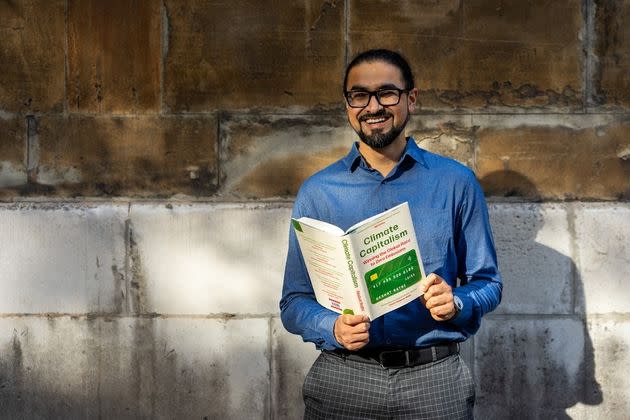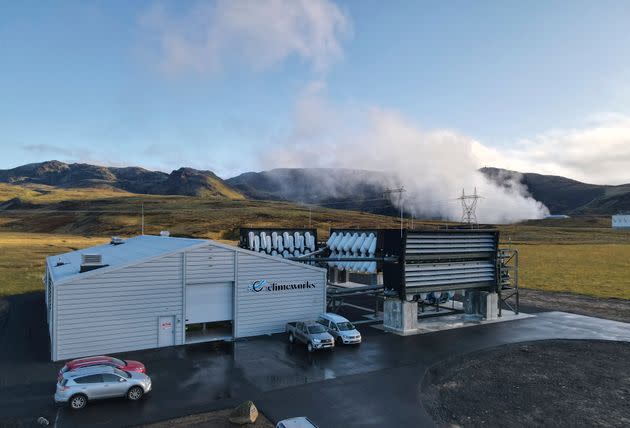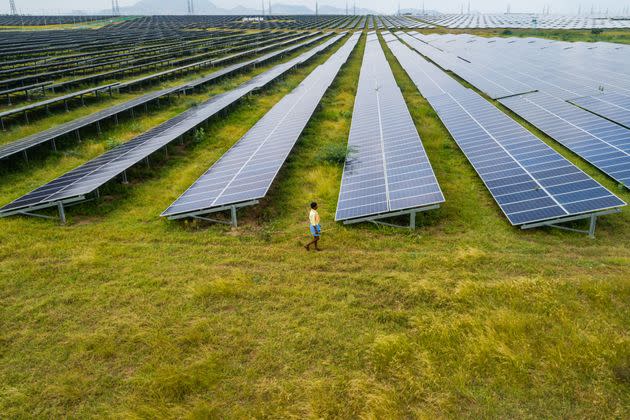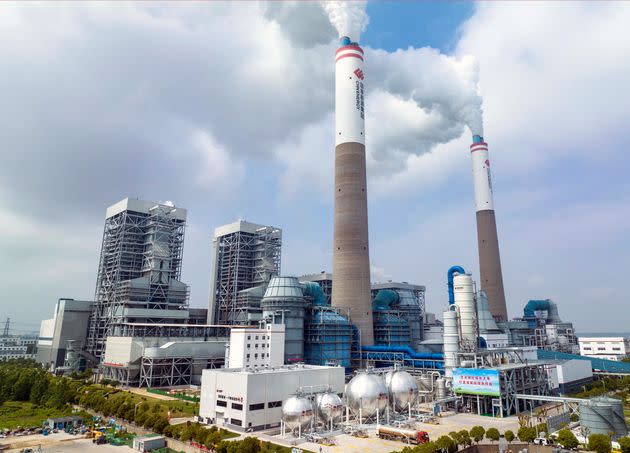The Oxford-Trained Chemist-Turned-Journalist Defending Climate Capitalism

In May 2019, I flew to Jackson Hole, Wyoming, to attend a conference on the future of carbon capture, the technology the oil industry was betting on to slash the climate impact of burning fossil fuels. Just six months after the release of a dire report giving humanity roughly a decade to halve emissions that were then still growing year over year, I braced myself for what I expected to be a roomful of unreformed climate deniers.
Instead, I spent most of two days listening to conversations detailing the surprisingly complex reality: technologies to keep carbon from leaving smokestacks and entering the atmosphere could actually work.
In particular, I heard Akshat Rathi, an Oxford-trained chemist and journalist, chat at length with Julio Friedmann, a former Department of Energy official-turned-academic now working to help commercialize the carbon capture tools he spent decades honing with federal research dollars. Rathi, who had written an acclaimed investigative series on the subject for Quartz, spoke of the actual science and hardware behind carbon capture — painting a broader picture that challenged many environmentalists’ blanket condemnation of the technology as a “false solution.”
From reading emissions studies and talking to modelers, it seemed obvious to me that the U.S. could not hit its emissions targets simply by strapping carbon capture equipment to aging coal plants. And I was sure that fossil fuel companies were dangling the technology’s still-unmet potential in front of policymakers to distract them from more promising solutions. But listening to Rathi and Friedmann made me realize how unlikely the U.S. is to meet its goals without carbon capture technology. It’s hard to see how we’d slash enough planet-heating pollution from heavy industry and other applications that can’t yet easily be swapped out for solar panels or batteries.
Moreover, the tools now used to capture CO2 at the source could lay the groundwork for the next generation of carbon capture tech: machines to essentially vacuum emissions out of the sky and bury them back underground.
Rewiring the global economy to run on different sources of energy will be no easy task, to put it mildly. And we’ll need to do it while continuing to expand access to electricity to the nearly 800 million people who still don’t have it, improving the grid for the billions more who lack steady supplies and maintaining quality of life in places where fossil fuels have long kept the lights on. Carbon capture could be a big part of that.
Yet the loudest advocate for using carbon capture was a U.S. president who appeared clueless about how the technology worked and dismissed the need to cut emissions at all.
“Donald Trump was campaigning on clean coal,” Rathi recalled in an hour-long conversation over Zoom earlier this month. “It’s just that he doesn’t understand it. Trump used to say, ‘You take the coal, you clean it and then you burn it.’ Instead, there’s carbon capture technology, where you take the coal, you burn it, then maybe you capture some of its emissions.”
Carbon capture makes up just one part of “Climate Capitalism,” Rathi’s 199-page debut, in which each chapter profiles a different executive, scientist or engineer making progress on solutions to cut emissions that could be applied worldwide.
Rathi, now a senior reporter on Bloomberg’s climate desk and the host of its climate-focused “Zero” podcast, is an able guide for a globe-spanning narrative that elevates familiar and at-times controversial names like Bill Gates (“the billionaire”) alongside those of China’s “battery king,” Zeng Yuqun (“the winner”) and an Indian farmer known only as Srinivas (“the doer”) whose decision to lease land to a solar company broke a cycle of generational poverty. Friedmann is “the wrangler” of the story.
The title is primed for blowback from those who say the only pathway to keeping the Earth habitable for humans is to eliminate capitalism altogether and transition to an economic system that wastes fewer resources. Rathi expects as much. The hip Marxist publisher Verso Books released academic Brett Christophers’ “The Price Is Wrong: Why Capitalism Won’t Save The Planet” just a month before Rathi’s book came out, and the two are ripe for comparison.
Rathi shares many critiques of the type of financialized laissez-faire form of capitalism that triumphed after the Cold War with his own critics on the left. But he points out that even leftist Noam Chomsky recognizes there’s not enough time to rewire the entire global economy to use far less fossil fuel and to peacefully reorder the rest of human society.
HuffPost spoke with Rathi this month about Western perceptions of economic growth, the evolution of climate denialism and what the climate crisis means for democracy. The following interview has been edited for clarity and length.
A lot of environmentalists blame climate change on capitalism, and frame the system as the cause of the problem. At the same time, obviously, we don’t have very much time to construct a whole new global economic system and decarbonize. Can you talk about the title of your book?
The original title, at least in my proposal to the publisher, was “The Existential Economy.” Again, there was alliteration there. But both words are perhaps too big and too boring to have stuck around on the cover of a book. The publisher was like, “Look, I enjoy this book, but I think you are making the case for capitalism being part of the solution here. Why don’t you just say it?” I’m like, “Fair enough.” I mean, the solutions that I’ve looked at around the world are being deployed in the capitalistic economy. They are changing capitalism, though, to make it work because the existing form of free or free-er markets has not been working. What you’re seeing around the world, in different ways, is bringing in more regulation. It is bringing in more direction. It is governments finding their own ability to try and shape the transition [in ways] that they had forgotten they had.
The U.S. does it through supercharging tax credits. The EU does it through a lot of bureaucratic rules around how to invest in green solutions. China does it through creating national champions and eventually export payments. In all those forms, there is a clear, capitalistic economy that has been reshaped for climate solutions. As I started reporting, the title is something we kept working on for a year or so. But the more I reported it, it felt right to be able to call it “Climate Capitalism,” and to be going on the road and defending that title. We spent a lot of time thinking, will I be able to explain to people what I mean when I say climate capitalism? And, yeah, I feel like it’s fair enough. Given the time we have left, we should look at what’s working and how to make it work better and work in other places, too.

How did growing up in India affect your perspective on the need for continued economic development and growth? The movement calling for “degrowth” that’s been gaining some traction in recent years seems to be largely coming from advanced economies and universities in places like Berlin or Boston or Japan, with Marxist academic Kohei Saito’s bestselling manifesto just coming out in English.
I saw lives change in my lifetime. That happened because of economic growth. As much as trickle-down economics may not be working in America or the U.K., it did work in India. That is not to say capitalism is the answer. But if it is one way in which we could see growth bringing benefits to humanity, then how about we find what made those benefits actually happen, and use the system to try to harness the forces that are pushing for progress, rather than the forces that corrupt capitalism?
The growth story is an interesting one. The reason why there is a lot of focus on degrowth or there is frustration with capitalism in the West is that the relative change that it has brought to Western economies in recent years has not been equally shared. It has been very unequal. Improvements to poor people’s lives in the U.S. and Europe [have] not been as [they] used to be a few decades ago. The injustice of that system is quite real. Capitalism has this tendency to want to concentrate wealth toward those with capital. Inequality is sort of built into the very algorithm in which capitalism operates. It[’s supposed to operate] in a society where it is the job of [the] governmen[t] to ensure that you don’t let those forces run amok. That’s where I think the biggest criticism of capitalism comes from. Most people, when they’re not able to clearly understand why it is that they aren’t benefiting from all this economic growth that they’re seeing around them, they blame capitalism, whereas they really should be blaming the government and electing the right leaders to ensure that these benefits are more widely shared.
Are there climate solutions or parts of the future economy that you think are less suited to market forces? I ask this with nuclear energy in mind, considering how France renationalized its state-owned energy company, as it prepares to go on another reactor building spree, or even just the push in states across the U.S. to bring utilities under municipal ownership.
Yes. If you look at just the climate solution side, markets have one thing that they do really well. They provide a price signal. They help you filter the noise and find what is working right. If the price of cobalt is too high, then you can replace it with nickel or you can replace it with aluminum, or you can move on to iron and make the batteries that you still wanted to make, but at a lower price. Those price signals are very important and the markets do a really good job of that. To use markets for the right reasons is beneficial.
But in some places, markets are not the answer. There are some types of infrastructure where you don’t want competition or there is no point in having competition. You don’t want two or three transmission grids for electricity. You want one transmission grid that works well, that keeps growing. And so you get a regulated monopoly in most parts of the world: grids [that] are either state-owned or they’re regulated fully by a government, and it’s a monopoly run by a particular company. That is fine, but the price signal over there is very different. You want to be able to use good, strong, clear regulations to actually make the grid work.
Nuclear is not ... a climate solution that is working at scale right now, which is strange to say given that in various parts of the world, 20% to 40% of clean energy, or even 50% of clean energy, is coming from nuclear. The reason it’s not working as a climate solution is it’s not scaling. Currently, the only country that is building nuclear at scale in the world right now is China. I wanted to go and try to report on nuclear in China, but I could not. Nuclear is, as an industry right now, being supported based on energy security and national security — reasons which are not a price signal. It is just governments wanting nuclear power because they believe having nuclear in the mix is necessary, either to have nuclear engineers so that they can continue to support their nuclear weapons arsenal, or [as] a form of baseload power that would be good to have in the mix. The more different types of technologies you have powering a grid that is going to be devoid of coal, gas and oil, the better it is to have more resilience on the grid. So you have governments taking on [a] financial burden which otherwise markets wouldn’t allow them to.
The second thing I wanted to say on this was there are certain types of climate solutions that just cannot work through markets. The book is about how we get to zero emissions. It’s about mitigation. But there are two other big buckets of solutions that need to work: adaptation and ... companies compensating for the climate impacts that come through.
In adaptation, there are some [market forces] that could still be applied. For example, many governments can build adaptation projects right now at a cheaper price, and avoid future costs of impacts that will come if these projects are not built. And governments can do that through issuing bonds that private investors will buy that are 30, 40, 50 years long in the payment cycle. You’re sort of borrowing from the future to pay for the present so that the future people don’t end up paying up. So it is a type of market-oriented solution, but requires governments to take on the burden of deploying the solution.
When it comes to compensation, that just has to come from foreign aid budgets, or that has to come from governments [taxing] profits of corporations or levying a fee on financial transactions or some other form of creative regulation that drives money towards the solution. On their own, no company is voluntarily going to give their profit away to try and compensate for people, at least not at scale.

I have suspected for a while now that climate denialism has far outlived its usefulness as an explanation for why we aren’t accomplishing everything that we need to do to meet climate goals. That makes inertia seem more like the primary thing holding us back, but there’s clearly momentum building. What do you see as the biggest obstacles and barriers to hastening climate action?
I think you’re right. Through the ’90s, even early 2000s, it was climate denialism. It was big oil companies, but also coal companies and utilities, sowing doubt about climate science that delayed climate action from happening, that stopped governments from taking it seriously. We have largely left that behind. The kind of climate delays we have now is more on raising doubts about whether certain types of solutions will work or not, or whether certain types of solutions like electric cars are real solutions or false solutions. ... There is more of a misinformation-disinformation type of problem in solutions now, rather than on questioning the very science, because climate impacts are all around us.
In terms of what is stopping more solutions from being deployed or being deployed faster, because clearly we are behind on our goals, there are two ways to answer that question.
One is that governments and people and corporations tend to operate on two very different timelines. One is the long-term horizon that every so often you have to think about ... But most of the time, you’re really thinking about your tomorrow, your next quarter, your next election.
Climate as a problem just falls in this difficult place where it is a long-term problem that we have to address. But the short-term priorities — the short-term problems of wars or of migration or food prices — just take up a lot more of the oxygen that governments have. One way in which we are starting to see climate action accelerating is when you can hit a climate solution that addresses a short-term problem and addresses climate.
Air pollution is a really good one. We know air pollution has immediate short-term impacts on health, and it has a long-term impact through carbon pollution on the planet. There is more increasing movement on health ... as a sort of motivation to try and act on climate.
Another one is where, at least in developing countries, energy access is a real fundamental need. There’s still 700 million people around the world who don’t have access to electricity at all, and then another billion or so people who don’t have access to consistent electricity. We know that clean energy is cheaper. We know it is distributed in nature. We know that microgrids can be built all around the world, and are being built. So it combines two big desires that governments have to deploy clean energy and to deploy energy for all. And that I think is becoming an accelerant.
A lot of questions about the future in the democratic West seem to rest on how you bridge the gap between the long-term planning and strategic guidance you need to deal with climate change, and the short-term focus corporations and governments maintain on quarterly earnings and biennial elections. Does this pose a threat to democracy?
That’s a very interesting way of thinking about it. There was a new book that came out a little bit before mine called “The Crisis of Democratic Capitalism” from a Financial Times columnist named Martin Wolf. In it, he makes the case that capitalism cannot work without strong democracies, because capitalism has these tendencies to want to concentrate wealth toward the top, so you need good government regulations to ensure that forces of capitalism can be harnessed for societal good, rather than for just private good. But he also makes [a] second case, which is that without having capitalism, democracies can’t work, because capitalism allows you to have private ownership — allows you to have an incentive or motive to be a good private citizen who can benefit from the work they’re doing. If [you] put in more work, [you] do get more out of it. This pull and push between democracy and capitalism is what enables the system to work as well as it has, with its many flaws, over the past 200 years.
But climate throws this wrench in the works, which Martin understands. He explores it a little bit, but I feel like us, as climate journalists, appreciate it a lot more. If we don’t address that problem, you’re going to start breaking the system down in ways that a stable climate would not have seen. You’re going to get migration [increasing exponentially] some parts of the world over the next few decades. That can create all kinds of ripple effects on politics.
Same thing is happening with agricultural productivity. We know that climate impacts can start to make certain places — and are already making [certain] places — just unproductive. They do not produce the kind of food that they used to. That causes migration, poverty increases, and then that causes all kinds of secondary impacts. So, yes, I think climate change — left to run its course — is likely to have a huge impact on the world in so many ways, but [is] also probably is a threat to democracy.

Back in the early 2010s, China’s subsidies to solar panel manufacturers drove U.S. and European factories out of business, prompting protective tariffs on both sides of the Atlantic. President Joe Biden’s Inflation Reduction Act includes tax credits to bring some of manufacturing back. But the recent influx in Chinese exports of cheap panels and electric cars is causing some economic commentators to warn of a “China shock 2.0.” How big an issue is this?
It’s such a live topic now. You see economic commentators — I think Dylan Matthews, probably, is the most recent one — saying, “Look, if you care about climate, stop worrying about China, because those people make those things cheapest and best, you should just take the cheapest and best and decarbonize as quickly as possible.” Americans would love a $10,000 EV, apparently. Then there are geopolitical commentators who are like, “We can’t allow for dependency on another power — especially one that does not have the same politics, and could be our next big threat — to hold sway over key industries. We can’t allow them to take our jobs away.”
It’s not a new debate. We’ve had these trade barriers around industry in industrial growth all through history. America, if anything, has been the home of a lot of industrial policy that’s been then copied around the world by other powers. The New Deal was then used by the Japanese to try and create their own auto manufacturing base in the 1930s through government tariffs or giving their industries domestic advantage. The same thing happened when America had Japanese cars coming in the 1980s.
It’s just that we are having the old debate in a new context. One of the most clarifying things for me when trying to understand this came from the work of Abhijit Banerjee, the Nobel Prize-winning economist. He basically said, “If you ask economists, they will all agree on two things: that trade is good and migration is good.” Trade gives you the ability to have comparative advantage — places that make something cheaper sell those to places that don’t make it as cheap. Those places buying those things can then make something else cheap and sell that back. Great! Migration is good because that allows for the people with the right skills going to these places making the right things. But it’s not like all the manufacturers of America moved to China because China is very good at manufacturing, or all the computer geeks have moved to America because America is very good at creating digital startups.
What Abhijit Banerjee finds is basically there’s a stickiness factor. People don’t move, and when people don’t move, it means Middle America, which has been hollowed out because those jobs have been lost and the people are still there. They don’t have jobs and they are experiencing poverty. They are then using that to change the politics that would hopefully find some way of helping them. That’s why you’re getting the Trumpian twist in American politics, but it’s happening in many different parts of the world. Even as trade barriers aren’t the most economically efficient way of solving the climate problem, they are a solution to the political problems that come from the climate solution[s] that we are deploying. At the end of the day, none of these solutions are going to work if we don’t bring people along in the transition. If it means that [it’s] going to be a less economically efficient way, that is better than not having the politics aligned with the transition at all.
Is there an area of climate activism you find more effective than others?
Climate activism is being scuttled right now by governments through either draconian policing laws or harsher punishments on protesting. That is actually not just a threat to climate action, that is a threat to democracy. Again, it’s that place where as climate reporters, we think about it from the climate lens, but it blends into so much of how society in general works. It’s one of those underappreciated problems, because activists have been seen as a nuisance to society more than service to society.
Related...
The U.S. Finally Has A Real Climate Law. Get Ready For More Pipelines.
Biden Finally Picks A Side In The Big Clean Energy Fight Dividing Democrats
Should We Spend $1 Trillion A Year On This Climate Technology? We May Have To.
Activists Call It A ‘False Solution.’ But UN Scientists Say We Need To Suck Up CO2.
